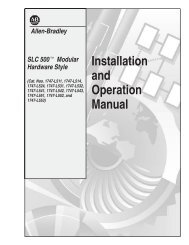1 Overview 2 Details of the Model Construction - Canada France ...
1 Overview 2 Details of the Model Construction - Canada France ...
1 Overview 2 Details of the Model Construction - Canada France ...
You also want an ePaper? Increase the reach of your titles
YUMPU automatically turns print PDFs into web optimized ePapers that Google loves.
4 Dye Probe Locations<br />
Dye probe ports were installed on <strong>the</strong> telescope floor, inside <strong>the</strong>, in <strong>the</strong> Cassegrain baffle and at several<br />
locations on <strong>the</strong> terrain. The probe ports consisted <strong>of</strong> 9/32” (7.1 mm) brass tubing fitted with Delrin<br />
caps and packed with dense open-cell foam (art foam) to provide friction. The Delrin caps were drilled<br />
to allow insertion <strong>of</strong> 17 gauge 304 stainless hypodermic tubing. The inner and outer diameter <strong>of</strong> <strong>the</strong><br />
tubing was 0.047” (1.19 mm) and 0.058” (1.47 mm), respectively. With this arrangement <strong>the</strong> stainless<br />
tubing could be easily moved up and down through <strong>the</strong> port to adjust <strong>the</strong> height <strong>of</strong> <strong>the</strong> probe in relation<br />
to <strong>the</strong> model. The probes external to <strong>the</strong> model (labeled “B” below) had a 90 o , 0.25” radius bend, ~0.5”<br />
(12.7 mm) long formed to allow <strong>the</strong> dye to be injected into <strong>the</strong> flow in a more laminar nature. The dye<br />
ports were labeled as follows;<br />
Inside <strong>the</strong> dome:<br />
A1: Probe installed so that <strong>the</strong> dye exits at <strong>the</strong> level <strong>of</strong> <strong>the</strong> Cassegrain mirror fold above <strong>the</strong><br />
primary mirror.<br />
A2: Probe on <strong>the</strong> north side <strong>of</strong> <strong>the</strong> telescope pier at a 2” (50.8 mm) radial distance from <strong>the</strong><br />
dome center.<br />
A3: Probe on <strong>the</strong> east side <strong>of</strong> <strong>the</strong> dome (same radial distance from <strong>the</strong> dome center as A2).<br />
A4: Probe on <strong>the</strong> south side <strong>of</strong> <strong>the</strong> telescope pier (same radial distance as A2).<br />
A5: Probe on <strong>the</strong> west side <strong>of</strong> <strong>the</strong> telescope pier (same radial distance as A2).<br />
Outside <strong>the</strong> dome:<br />
B1, B2, B3, B4, B5: Probes from North to South respectively on <strong>the</strong> upwind (east) side <strong>of</strong> <strong>the</strong><br />
dome, 7.5 cm distant from <strong>the</strong> building measured along an east/west line.<br />
B6: Probe located directly upwind (east) on <strong>the</strong> down-slope <strong>of</strong> <strong>the</strong> terrain, 20.7 cm from <strong>the</strong><br />
dome building as projected on <strong>the</strong> horizontal plane.<br />
B7: Probe located directly downwind (west) <strong>of</strong> <strong>the</strong> dome, approximately 4 cm from <strong>the</strong><br />
building.<br />
Probes B1 to B7 could be inserted to be at any level, from a maximum extension in level with <strong>the</strong><br />
mezzanine to being totally retracted in <strong>the</strong>ir grooves; this permitted us to visualize <strong>the</strong> flow at various<br />
heights above <strong>the</strong> terrain.<br />
5 The UWAL 30” Water Tunnel Facility<br />
The UWAL 30” water tunnel is located in <strong>the</strong> Aerodynamics Laboratory on <strong>the</strong> UW main campus in<br />
Seattle Washington. Jack Ross (electrical engineer) is <strong>the</strong> business manager for <strong>the</strong> Kirsten Wind<br />
Tunnel as well as for <strong>the</strong> water tunnel facility. The water tunnel itself is maintained by Robert Gordon<br />
(research engineer) and was originally built by pr<strong>of</strong>essor Robert (Bob) Breidenthal and his students.<br />
Following is <strong>the</strong> contact information for <strong>the</strong>se individuals:<br />
Jack Ross: 206 543-0439, jwross@u.washington.edu<br />
Robert Gordon: 206 685-3011 (<strong>of</strong>fice), 206 713-2971 (cell), deepsnow@aa.washington.edu<br />
Robert Breidenthal: 206 685-1098, breident@aa.washington.edu<br />
The CFHT staff involved in performing <strong>the</strong> tests in Seattle were Karun Thanjavur, Tom Benedict and<br />
Marc Baril. Derrick Salmon observed and provided guidance via internet teleconference from Waimea.



![Documentation [PDF] - Canada France Hawaii Telescope ...](https://img.yumpu.com/26965302/1/190x245/documentation-pdf-canada-france-hawaii-telescope-.jpg?quality=85)








